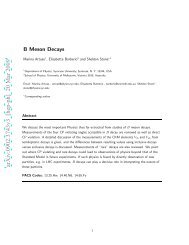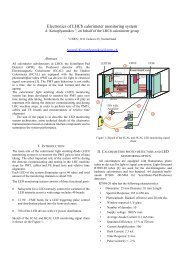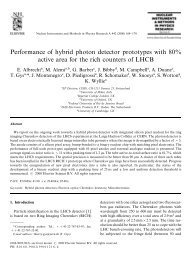Measurement of CP violation and CKM matrix in LHCb
Measurement of CP violation and CKM matrix in LHCb
Measurement of CP violation and CKM matrix in LHCb
You also want an ePaper? Increase the reach of your titles
YUMPU automatically turns print PDFs into web optimized ePapers that Google loves.
EPS – HEP 09 Krakow 16-22 July 2009<br />
<strong>Measurement</strong> <strong>of</strong> <strong>CP</strong> <strong>violation</strong><br />
<strong>and</strong> <strong>CKM</strong> <strong>matrix</strong> <strong>in</strong> <strong>LHCb</strong><br />
Marta Calvi<br />
University <strong>of</strong> Milano Bicocca <strong>and</strong> INFN
<strong>CP</strong> <strong>violation</strong> <strong>and</strong> <strong>CKM</strong> <strong>matrix</strong><br />
• Current laboratory measurements <strong>of</strong> <strong>CP</strong>V <strong>CP</strong>V are <strong>in</strong> <strong>in</strong> agreement with<br />
SM predictions, encoded <strong>in</strong> the <strong>CKM</strong> <strong>matrix</strong>, but<br />
observation <strong>of</strong> universe requires much more.<br />
• Unitarity relations represented by triangles.<br />
“db”<br />
Still space for f<strong>in</strong>d<strong>in</strong>g effects due to NP <strong>in</strong> less constra<strong>in</strong>ed<br />
elements like γ <strong>and</strong> βs angles.<br />
HEP 2009 - M.Calvi<br />
UT constra<strong>in</strong>ts from tree<br />
measurements only <br />
“sb”<br />
2
The B B0 sB0 mix<strong>in</strong>g <strong>in</strong> B 0J/ J/ψφ ψφ<br />
s s<br />
• A <strong>CP</strong> violat<strong>in</strong>g phase arises from <strong>in</strong>terference between B Bs decay<br />
to J/ J/ψφ ψφ ψφ ψφ directly or via mix<strong>in</strong>g<br />
• In the SM:<br />
Bs J/ J/ψφ ψφ ψφ is dom<strong>in</strong>ated dom<strong>in</strong>ated by a s<strong>in</strong>gle weak weak phase, well predicted:<br />
HEP 2009 - M.Calvi<br />
Φ J/<br />
SM<br />
J/ψφ ψφ ψφ<br />
SM = -2βs<br />
+ δP Pengu<strong>in</strong> contribution<br />
s +<br />
estimated ~ ~10 10-4-10 -2βs = (-0.037 ( 0.037±0.002) 0.002) rad from UT fits<br />
B s<br />
B s<br />
f =J/ψφ ψφ<br />
10 -3<br />
3
B0 sB0 with New Physics<br />
s<br />
• New particles could contribute to the B Bs-Bs box diagram modify<strong>in</strong>g<br />
the SM prediction, add<strong>in</strong>g a new phase :<br />
• This new phase will also modify other measurements:<br />
where:<br />
HEP 2009 - M.Calvi<br />
is calculated <strong>in</strong> the SM:<br />
4
Differential<br />
decay rate:<br />
B 0J/ J/ψ(µµ)φ(ΚΚ)<br />
ψ(µµ)φ(ΚΚ)<br />
s<br />
PVV VV decay : mixture <strong>of</strong> <strong>CP</strong> <strong>CP</strong>-even even<br />
(ℓ=0,2) <strong>and</strong> <strong>CP</strong> odd (ℓ=1) f<strong>in</strong>al states.<br />
An angular analysis allows to separate<br />
statistically the decay amplitudes.<br />
3 angles Ω=( Ω=( θ,φ,ψ θ,φ,ψ<br />
) ) to describe the f<strong>in</strong>al decay products directions.<br />
A0 (0) <strong>CP</strong> even<br />
A || (0) <strong>CP</strong> even<br />
A⊥ (0) <strong>CP</strong> odd<br />
HEP 2009 - M.Calvi<br />
Bs<br />
Bs<br />
5
Time dependent decay amplitudes amplitudes<br />
Depend on 8 physics parameters:<br />
Φ, Γ s, ∆Γ s, ∆m s, R ┴, R ||, δ ┴, δ ||<br />
From Tevatrons results:<br />
∆ms well measured, h<strong>in</strong>ts<br />
<strong>of</strong> deviation from SM <strong>in</strong> Φ<br />
HEP 2009 - M.Calvi<br />
High sensitivity<br />
to small Φ values<br />
when B/B <strong>in</strong>itial<br />
state is determ<strong>in</strong>ed<br />
by Flavour tagg<strong>in</strong>g<br />
(∆ms terms)<br />
6
<strong>LHCb</strong> @ LHC<br />
High bb production <strong>in</strong> pp collisions at √s= s=14TeV 14TeV<br />
σ <strong>in</strong>el = 80 mb<br />
σ bb = 500 µb b N ∼10 10 12 bb events <strong>in</strong> L <strong>in</strong>t = 2 fb fb-1 1<br />
(1 nom<strong>in</strong>al year 10 107 s at 2x10 32 cm -2s-1 )<br />
~40% <strong>in</strong> the forward region<br />
<strong>LHCb</strong> s<strong>in</strong>gle arm forward detector<br />
HEP 2009 - M.Calvi<br />
TED data June 2009<br />
(secondary particles<br />
bb angular<br />
correlation <strong>in</strong> pp<br />
collisions at<br />
√s=14 TeV<br />
Detector ready<br />
<strong>and</strong> operational<br />
downstream LHC beam stopper)<br />
7
B 0J/ J/ψ(µµ)φ( ψ(µµ)φ(KK KK) ) reconstruction<br />
reconstruction<br />
s<br />
Full MC simulation<br />
all trigger levels<br />
<strong>in</strong>cluded:<br />
Signal yield (2 fb -1 ) 117 k<br />
B(long-lived) /S 0.5<br />
B(prompt J/ψ) ψ) /S 1.6<br />
• High efficiency for di di-muon muon trigger εtot~70% tot~70%<br />
• Basel<strong>in</strong>e event selection is lifetime lifetime-unbiased: unbiased:<br />
Full MC: <strong>in</strong>clusive J/ψ(µµ)<br />
small proper time <strong>and</strong> angular acceptance corrections needed.<br />
High background from prompt J/ J/ψ: ψ: ψ: harmless <strong>in</strong> βs fit,<br />
can allow the determ<strong>in</strong>ation <strong>of</strong> proper time resolution.<br />
Alternative analysis under study: higher statistic sensitivity.<br />
• Large use <strong>of</strong> control channels:<br />
Measure resolution <strong>and</strong> acceptance for<br />
proper time <strong>and</strong> angular distributions.<br />
Flavour tagg<strong>in</strong>g<br />
HEP 2009 - M.Calvi<br />
Channel Yield<br />
(2 fb -1 )<br />
B/S<br />
total<br />
BdJ/ψ ψ ψ K* 490 k 6.7<br />
BuJ/ψ ψ K+ 940 k 1.9<br />
B sD sπ ~70k 0.4<br />
8
B0J/ψ(µµ) ψ(µµ) ψ(µµ)K*(Kπ) ψ(µµ) oscillations<br />
for opposite side taggers<br />
Flavour Tagg<strong>in</strong>g<br />
Tagger Tag eff. mistag ε(1 ε(1−2ω ε(1 2ω 2ω) 2ω 2<br />
From comb<strong>in</strong>ation <strong>of</strong> several methods (electron, muon, kaon,<br />
<strong>in</strong>clusive vertex, same side kaon)<br />
B<br />
Qvtx –<br />
µ −, e− K –<br />
Opposite side 45% 36.5% 3.3%<br />
+ same side 56% 33.3% 6.2%<br />
Calibration <strong>and</strong> validations on control channels<br />
HEP 2009 - M.Calvi<br />
PV<br />
K +<br />
Bs<br />
BsD s (KK KKπ) ) π π oscillations<br />
for same side tagger<br />
9
ψ<br />
B 0J/ J/ψφ ψφ : fits results<br />
s<br />
• Sensitivity studies with 2fb 2fb-1 (one nom<strong>in</strong>al year) : σ(2β σ(2βs) σ(2β ) ~0.03<br />
Good convergence for all physics parameters, all “detector parameters” can also be fitted.<br />
• Systematics<br />
Systematics: : Angular distortions<br />
distortions (± 5%) 77%<br />
%<br />
Proper time resolution ( (40 40 ± 4 fs fs) ) 5%<br />
Mistag rate (0.34 ( 0.34 ± 0.01) 77%<br />
%<br />
∆β s/β s<br />
Ignor<strong>in</strong>g a possible 55-10<br />
10% % S-wave wave contam<strong>in</strong>ation will <strong>in</strong>troduce a ~15 15% % bias on βs. .<br />
Included <strong>in</strong> the fit will reduce the resolution ~20 20% but allows cos2 cos2βs measurement<br />
HEP 2009 - M.Calvi<br />
θ φ<br />
τ<br />
10
Sensitivity versus <strong>in</strong>tegrated Lum<strong>in</strong>osity<br />
First important results can come already from 2010 runn<strong>in</strong>g.<br />
Reduced<br />
LHC collision<br />
energy √s=14TeV<br />
If true βs value is the current Tevatron measurement (NP ( NP-like) like)<br />
we should measure it from BsJ/ J/ψ(µµ)φ ψ(µµ)φ ψ(µµ)φ ψ(µµ)φ with 200 pb<br />
pb -1<br />
With 10 fb -1 > 33σ<br />
evidence <strong>of</strong> non non-zero zero βs even if only SM.<br />
Other channels also under study: BsJ/ J/ψ( ψ( ψ(ee ψ( ee)φ )φ )φ, )φ )φ )φ,<br />
BsJ/ J/ψη ψη ψη, ψη , , B +<br />
sD s Ds<br />
− …<br />
1 !<br />
11
s<strong>in</strong>(2 s<strong>in</strong>(2β) ) with B0J/ J/ψ(µµ) ψ(µµ)KS(ππ ππ)<br />
Will be the first time dependent <strong>CP</strong><br />
asymmetry measurement at <strong>LHCb</strong>: <strong>LHCb</strong><br />
with 200 pb -1 expect expect σ(s<strong>in</strong>2 (s<strong>in</strong>2β β β )~0.06<br />
Channel Signal yield<br />
(2 fb -1 )<br />
σ(s<strong>in</strong>2 (s<strong>in</strong>2β β β )~0.020 <strong>in</strong> 2 fb fb-1 B/S<br />
B dJ/ψ K S 94 k 0.6<br />
With additional lum<strong>in</strong>osity will give <strong>in</strong>sight <strong>in</strong>to possible NP contributions<br />
to bccs ccs. . Will also constra<strong>in</strong> constra<strong>in</strong> direct direct <strong>CP</strong> asymmetry.<br />
NP from b→sss sss pengu<strong>in</strong> decays<br />
Good perspective at <strong>LHCb</strong> for Bs→φφ φφ φφ. φφ<br />
Channel Yield (2 fb -1 ) B/S (90% CL)<br />
Bs → φ φ φ 3100 < 0.8<br />
Bd → φ φ KS 920 < 1.1<br />
HEP 2009 - M.Calvi<br />
Time dependent analysis <strong>of</strong> angular<br />
distribution <strong>of</strong> flavour tagged events:<br />
σ stat ( φ Bs → φφ NP ) = 0.11 <strong>in</strong> 2 fb –1<br />
φφ<br />
φφ<br />
From B d →φK S expect σ(s<strong>in</strong>2β eff) ≈0.23<br />
12
+<br />
B<br />
b<br />
u<br />
u<br />
s<br />
c<br />
u<br />
+<br />
K<br />
0<br />
D<br />
γ measurements<br />
● Many approaches to γ angle measurements. Most powerful through<br />
‘B ‘BDK’ DK’ strategies (charged <strong>and</strong> neutral B modes). D f<strong>in</strong>al state is<br />
common to D D0 <strong>and</strong> D D0 .<br />
+<br />
B<br />
b<br />
u<br />
● Opportunity for <strong>LHCb</strong> to make a contribution already with 200 pb -1<br />
expect ~10k events BD( D(hh hh)K )K .<br />
● Dalitz plot analysis giv<strong>in</strong>g currently the s<strong>in</strong>gle best γ results: <strong>LHCb</strong> will<br />
reconstruct <strong>in</strong> BD( D(KSππ ππ ππ ππ ππ)K ππ ππ ππ)K<br />
~6.800 events /2 fb -1 with B/S
• <strong>LHCb</strong><br />
Conclusions<br />
<strong>LHCb</strong> detector is on place <strong>and</strong> operational, ready for data tak<strong>in</strong>g<br />
at LHC start start-up. up.<br />
• 2β<br />
2β<br />
2β s value could br<strong>in</strong>g good news for NP: first <strong>LHCb</strong> results could<br />
come already from 2010 runn<strong>in</strong>g. Expected sensitivity ~0.03/ 2 fb fb-1 • Extensive<br />
Extensive <strong>LHCb</strong> program <strong>in</strong>cludes studies on many hadronic<br />
channels for measurements on all <strong>CKM</strong> <strong>matrix</strong> parameters,<br />
as well as searches for rare decays.<br />
• First year data will also provide a lot <strong>of</strong> <strong>in</strong>clusive measurements<br />
<strong>and</strong> studies on control channels.<br />
• In the com<strong>in</strong>g years <strong>LHCb</strong> results will f<strong>in</strong>ally provide a strong<br />
improvement to flavour physics, <strong>in</strong> particular to the knowledge<br />
<strong>of</strong> the B Bs sector.<br />
HEP 2009 - M.Calvi<br />
14
HEP 2009 - M.Calvi<br />
BACKUP<br />
15
Angular acceptance checks with B0J/ J/ψK* K*<br />
• <strong>Measurement</strong> <strong>of</strong> polarization amplitudes <strong>and</strong> phases <strong>in</strong> the B0J/ J/ψK* *<br />
decay from fit to time dependent angular distributions<br />
distributions.<br />
• Comparison with exist<strong>in</strong>g results from from B Factories <strong>and</strong> Tevatron will<br />
validate the use <strong>of</strong> simulated acceptance functions <strong>and</strong> allow estimation<br />
<strong>of</strong> systematic uncerta<strong>in</strong>ties to 2β 2β 2βs<br />
related to angular acceptance.<br />
• Strong constra<strong>in</strong> already for a ± 5% modified<br />
angular acceptance .<br />
HEP 2009 - M.Calvi<br />
θ<br />
±5% modification<br />
<strong>of</strong> acceptance<br />
16













